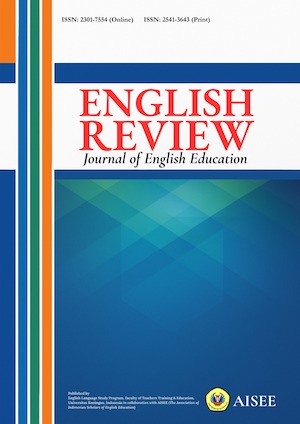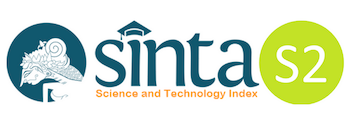IMPROVING STUDENTS’ SPEAKING SKILL BY USING MULTIMEDIA PRESENTATION STRATEGY
Abstract
Multimedia presentation strategy is one of strategies that can be used for developing students’ speaking skills. Therefore, this research is intended to describe how multimedia presentation strategy can improve the eighth graders’ speaking skills. A collaborative classroom action research design was employed in this research. This action research was conducted in four main steps, namely planning, implementing, observing, and reflecting. To collect the data, some instruments, i.e. students’ oral performance test, the observation checklist, field notes, and questionnaire, were used. The result showed that the students’ speaking performance improved from 64.29% in Cycle 1 to 100% in Cycle 2. Meanwhile, the students’ involvement has achieved the criteria of success (100% of students) in Cycle 1. Here, they could fulfill at least 2 out of 4 indicators in Cycle 1 and Cycle 2. In addition, the students’ perception towards the implementation of Multimedia Presentation strategy was 94.29% and only 5.71% of students who were not interested in the implementation of Multimedia Presentation strategy in teaching speaking skills. Hence, it can be concluded that Multimedia Presentation strategy can improve students’ speaking skill.
References
Burns, A. & Joice, H. (1993). Focus on speaking (2nd edition). Sydney: Macquarie University.
Kemmis, S., & McTaggart, R. (1988). The action research planner. Gee Long: Deakin University Press.
Male, M. (2003). Technology for inclusion. USA: Pearson Education Group.
Nunan, D. (1989). Designing tasks for the communicative classroom. Cambridge: Cambridge University Press.
Parveen, B. W. (2016). Use of technology in improving speaking skills. Journal of English Language and Literature (JOELL), 3(2).
Pusat Kurikulum (Puskur). (2006). Standar isi bahasa Inggris (Content standard for English). Jakarta.
Richards, J. C., & Renandya W. A. (Eds). (2002). Methodology in language teaching: An anthology of current practice. Cambridge: Cambridge University Press.
Spratt, M., Pulverness, A., & Williams, M. (2005). The TKT (Teaching Knowledge Test) course. Cambridge: Cambridge University Press.
Ur, P. (1996). A course in language teaching: Practice and theory. Cambridge: Cambridge University Press.
Wang, H., & Gearhart, D. L. (2006). Designing and developing web-based instruction. New Jersey: Pearson Education Inc.
All articles published in English Review: Journal of English Education (ERJEE) are licensed under the Creative Commons Attribution 4.0 International License (CC BY 4.0).
Copyright Ownership
Authors retain the copyright of their articles and grant ERJEE the right of first publication. The journal is granted a non-exclusive license to publish, reproduce, and distribute the article in any format, medium, or platform, provided that proper credit is given to the original authors.
License Terms – CC BY 4.0
Under the Creative Commons Attribution 4.0 International License, others are free to:
- Share — copy and redistribute the material in any medium or format
- Adapt — remix, transform, and build upon the material for any purpose, even commercially
As long as they:
- Provide appropriate credit to the original author(s) and source
- Provide a link to the license (https://creativecommons.org/licenses/by/4.0/)
- Indicate if any changes were made
There are no restrictions on the reuse, reproduction, or adaptation of published articles as long as attribution is properly given.
Author Warranties
By submitting a manuscript to ERJEE, authors confirm that:
- The work is original and does not infringe any existing copyright.
- The manuscript has not been previously published and is not under consideration elsewhere.
- All sources and references are appropriately acknowledged.
- Necessary permissions have been obtained for any copyrighted materials used.









